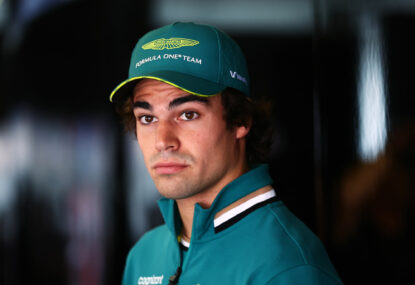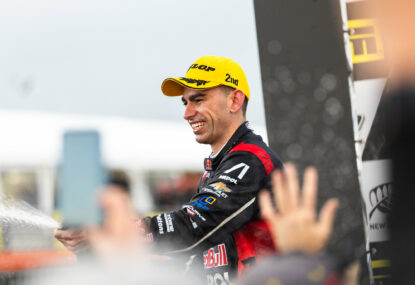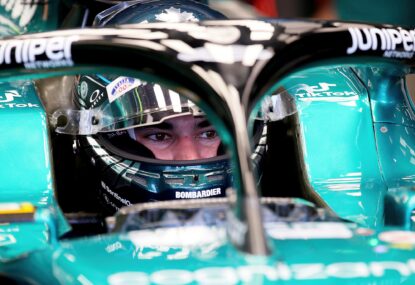“The great strength of Formula One from the late ’60s until quite recently was that we had Cosworth, Mecachrome and other people making engines so we weren’t in the hands of the manufacturers,” Max Mosley told German broadcaster ZDF this week in a joint interview with Bernie Ecclestone.
“The moment you have one or two or even three manufacturers and they are involved at board level – so [Mercedes boss] Mr Zetsche can talk to [Ferrari president] Mr Marchionne or [Renault president] Mr Ghosn – then they control Formula One, you don’t control Formula One.”
There was something beautifully surreal in this unusual double-act taking place in a room dominated by a life size bronze bust of Ecclestone himself. Perhaps the intended feeling was one of a message being handed down from up high, rather than the ultimate result of an old power couple having lost control through mechanisms of their own making.
But as Formula One lurches from crisis to crisis, with audience and attendance numbers in decline worldwide and its commercial structure under the microscope of the European Commission, any solution to whatever ills may be befalling the sport – different depending on who you talk to – is worth considering.
Too much power shared among too few engine manufacturers? Sure, we can run with that for now.
Formula One is a sport of ostensibly 11 teams from 2016 running just four engines, only two of which could currently be described as genuinely competitive.
Mercedes, which has been by far the most successful engine manufacturer since the 2014 introduction of the modern turbocharged V6 hybrid power units currently utilised by all teams, will power four teams – more than one-third of entrants, including its works team – with engines in 2016.
Ferrari has confirmed three teams will be on its books for next season, with the possibility of Toro Rosso taking a supply of 2015-spec power units, Honda supplying only McLaren, and Renault, if it does not quit the sport, supplying what is currently called Lotus.
With smaller teams relying on keeping it sweet with their suppliers – one need only consider Red Bull Racing’s predicament to understand why a bad supplier-team relationship is a recipe for disaster – especially when power units make up an onerous chunk of an independent team’s annual budget, some amount of political power is transferred away from the teams into the hands of Mercedes, Ferrari, Renault and/or Honda.
With Mercedes and Ferrari obviously being the desirable contracts, they, in turn, wield more power than the rest. But even this would be surmountable in serious regulatory log-jams if all teams, along with various other stakeholders, had a say in the direction of the sport.
Enter the strategy group.
By the will of Ecclestone, the Formula One strategy group came into being. It is a body comprising Ecclestone, the FIA, and six of the most powerful teams, among them Mercedes, Ferrari, McLaren-Honda and, until now, Red Bull Racing-Renault.
In other words, only the works teams, along with two smaller teams, which both happen to be Mercedes-powered this season, have access.
“The moment you have one or two or even three manufacturers and they are involved at board level … they control Formula One, you don’t control Formula One,” again, were Mosley’s words, perhaps inadvertently, describing Ecclestone’s regulatory mess.
But then Mosley is hardly blameless, having granted Formula One’s commercial rights to an Ecclestone-controlled business for a ludicrous 100-year-plus lease, which eventuated in this painful unravelling of the sport’s political hierarchy.
So what would an alternative look like?
Ideally the sport needs a minimum of six engine manufacturers, with each marque supplying two teams. This would make designing power units that suit both cars relatively straightforward and similarly mean fewer situations like that currently facing Mercedes, which is unable to build enough of its latest-spec engines for all its customers.
Having fewer teams per contract would also allow teams and engine manufacturers to work more closely, enabling something similar to a works relationship and thus providing the engine with a maximum publicity return through the team.
Most pertinently, political power would be more evenly distributed across the grid, and perhaps more representative of the genuine interests of teams, rather than that of their upper-grid suppliers.
But how to attract power unit suppliers in the first place, when the cost of development is prohibitively expensive? Perhaps with those novel things ‘regulatory stability’ and ‘economic certainty’.
Which of course brings us back to the start.
Why would any major motoring firm invest money in restrictive engine formulae in a sport that is governed by a body as dysfunctional as the strategy group, with power already concentrated in the hands of what will be its chief rivals, and facing a potential anti-competition investigation to boot?
And how did we get here in the first place? Makes you think…




































































































